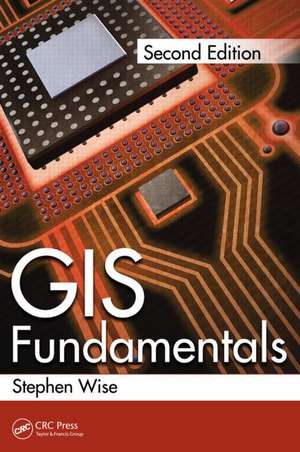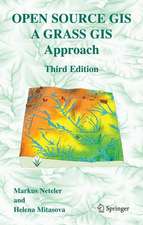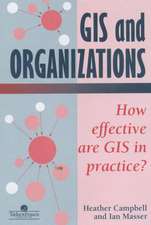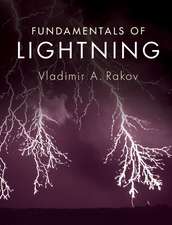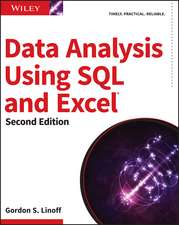GIS Fundamentals
Autor Stephen Wiseen Limba Engleză Paperback – 25 sep 2013
See What’s New in the Second Edition:
- Coverage of the use of spatial data on the Internet
- Chapters on databases and on searching large databases for spatial queries
- Improved coverage on route-finding
- Improved coverage of heuristic approaches to solving real-world spatial problems
- International standards for spatial data
Using clear, concise language, but without sacrificing technical rigour, the book gives readers an understanding of what it takes to produce systems which allow them to find out where to make their next purchase and how to drive to the right place to collect it.
Preț: 332.24 lei
Preț vechi: 415.31 lei
-20% Nou
Puncte Express: 498
Preț estimativ în valută:
63.59€ • 69.10$ • 53.45£
63.59€ • 69.10$ • 53.45£
Carte disponibilă
Livrare economică 31 martie-14 aprilie
Livrare express 15-21 martie pentru 32.84 lei
Preluare comenzi: 021 569.72.76
Specificații
ISBN-13: 9781439886953
ISBN-10: 1439886954
Pagini: 344
Ilustrații: 218 b/w images, 12 tables and Approx. 15 to 30 equations
Dimensiuni: 156 x 234 x 20 mm
Greutate: 0.57 kg
Ediția:Revizuită
Editura: CRC Press
Colecția CRC Press
Locul publicării:Boca Raton, United States
ISBN-10: 1439886954
Pagini: 344
Ilustrații: 218 b/w images, 12 tables and Approx. 15 to 30 equations
Dimensiuni: 156 x 234 x 20 mm
Greutate: 0.57 kg
Ediția:Revizuită
Editura: CRC Press
Colecția CRC Press
Locul publicării:Boca Raton, United States
Public țintă
UndergraduateRecenzii
"Steve Wise has produced a book that is a marvelous complement to GIS courses, taking the reader on an excursion back to the fundamentals of spatial representation. Vectors, rasters, surfaces and networks are explained in depth and enrich the study of GIS to the point where students can progress their knowledge of the field to practical and professional applications."
––Michael Batty, Centre for Advanced Spatial Analysis, University College London, UK
"After having had the pleasure of being reviewer of the first edition of the book, it is great to see the success continued in the second version. Given the transition from stand-alone GIS to a crucial component in the information infrastructure of today’s society, the extended coverage of data management in the new version is an important improvement. …the book gives clear insight into the Geo-ICT machinery to a much wider audience than just computer scientists."
––Peter van Oosterom, Delft University of Technology, South Holland, Netherlands
Clearly and engagingly written, and importantly free from unnecessary jargon, this text provides a helpful and well-considered overview of the ‘inside’ workings of GIS. This is a book for students and other GI users wishing to develop more than just good software skills by strengthening their knowledge and understanding of the science and technology that underpins GIS.
—Graham Smith, UNIGIS UK, Manchester Metropolitan University
––Michael Batty, Centre for Advanced Spatial Analysis, University College London, UK
"After having had the pleasure of being reviewer of the first edition of the book, it is great to see the success continued in the second version. Given the transition from stand-alone GIS to a crucial component in the information infrastructure of today’s society, the extended coverage of data management in the new version is an important improvement. …the book gives clear insight into the Geo-ICT machinery to a much wider audience than just computer scientists."
––Peter van Oosterom, Delft University of Technology, South Holland, Netherlands
Clearly and engagingly written, and importantly free from unnecessary jargon, this text provides a helpful and well-considered overview of the ‘inside’ workings of GIS. This is a book for students and other GI users wishing to develop more than just good software skills by strengthening their knowledge and understanding of the science and technology that underpins GIS.
—Graham Smith, UNIGIS UK, Manchester Metropolitan University
Notă biografică
Stephen Mark Wise is a senior lecturer in the Department of Geography at the University of Sheffield, UK. His teaching and research is mostly concerned with GIS.
Cuprins
Introduction. Databases. Vector Data Structures. Vector Algorithms for lines. Vector Algorithms for Areas. The Efficiency of Algorithms. Raster Data Structures. Raster Algorithms. Spatial Indexing. Data Structures for Surfaces. Algorithms for Surfaces. Data Structures and Algorithms for Networks. Future Developments.
Descriere
Aimed at readers with a knowledge of geographic information systems (GIS) but no formal training in computer science, this book provides a clear and accessible introduction to how GIS store and process spatial data. This updated edition includes two new chapters on databases and heuristics, substantial additional material on indexing and raster imagery, and revisions throughout that incorporate up-to-date applications such as GPS on mobile devices and Internet-based services.
